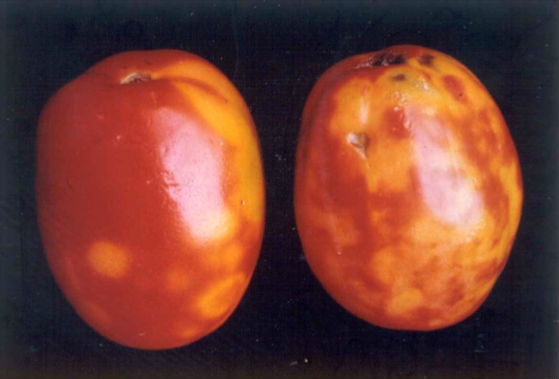


The largest database of plant viruses in Brazil serves as a tool for researchers, growers and policymakers (photo: tomatoes with necrotic ringspots caused by Tospovirus / Elliot Watanabe Kitajima)
Published on 03/19/2021
By Maria Fernanda Ziegler | Agência FAPESP – A Brazilian scientist has produced an inventory of 219 pathogens that infect plants in Brazil, including many agriculturally important species. The annotated list, published in Biota Neotropica, is the largest compilation of information on plant viruses ever produced in Brazil. It presents descriptions of the microorganisms, data on the diseases they cause, and information on their occurrence in native, cultivated and ornamental plants as well as weeds.
“Since the start of my career, I’ve been in the habit of collecting publications on plant viruses in Brazil. I’ve been doing it for decades and have recorded some 8,000 references to date,” said the author, Elliot Watanabe Kitajima, a researcher in the Phytopathology and Nematology Department of the University of São Paulo’s Luiz de Queiroz College of Agriculture (ESALQ-USP).
“I eventually realized that if I were asked how many viruses have been recorded in Brazil, I wouldn’t know the answer, so I drew up an alphabetic list of plant species and of the viruses that naturally infect them. I also produced a reverse list in which the viruses and viroids are followed by the plants infected by each one.”
Viroids are the smallest infectious pathogens known to science, consisting of a short strand of RNA with no protein coating. All known viroids are inhabitants of higher plants, and most cause diseases.
Dr. Kitajima graduated in agronomy from ESALQ-USP in 1958 and earned his PhD in 1967 at the same institution. His résumé includes positions as a researcher at the Agronomic Institute (IAC), an agency of the São Paulo State Government, as a professor at the University of Brasília (UnB) and as a visiting professor at his alma mater, where he retired in 2006 and works as a research collaborator.
The inventory is the outcome of projects conducted under the aegis of the FAPESP Research Program on Biodiversity Characterization, Conservation, Restoration and Sustainable Use (BIOTA-FAPESP).
“This review of the viruses documented between 1926 and 2018 basically sums up everything known about plant viruses in Brazil that infect both spontaneous and cultivated vegetation. The author has produced a most important database that will be both useful to researchers and a relevant pest prevention policy input,” said Carlos Joly, a professor at UNICAMP and a member of BIOTA-FAPESP’s steering committee.
Joly also stressed the importance of the inventory to economic activity. “The list includes 346 plant species belonging to 74 different families and the viruses that naturally infect them. Several viruses are listed for such important crops as the citrus group, for example. Many are well known, but others aren’t. In any event, the occurrence of these pathogens affects fruit production and quality. The ability to recognize them quickly can prevent harm and avoid losses,” Joly said.
Most of the viruses and viroids in the inventory are recognized by the International Committee on Taxonomy of Viruses (ICTV), which authorizes and organizes taxonomic classification and nomenclature. Some of the microorganisms listed have yet to be officially recognized. The list maps the history of pathogenic occurrences in Brazilian agriculture and the evolution of plant virology in Brazil as well as the main centers of research in the field.
For example, citrus tristeza virus (CTV) is one of the top 20 viruses in molecular plant pathology. It causes citrus plants to decline quickly and is the most economically important citrus disease worldwide, being responsible for enormous losses, including the destruction of some 10 million orange trees in the 1940s. This problem was solved on the basis of scientific research, and the state of São Paulo became the world’s largest producer and exporter of industrialized orange juice.
Another important crop pest is bean golden mosaic virus, which emerged in the 1970s, when Brazil was one of the world’s leading producers of beans but had to import the commodity from Mexico owing to the severe losses caused by the disease. Additionally, mosaic is caused in papaya by papaya ringspot virus (PRSV). This disease has wiped out entire plantations in Brazil. Control by roguing (systematic removal of diseased plants) has been sufficiently effective to enable the state of Espírito Santo, which pioneered the technique, to become a major exporter of papaya.
“No viruses can be considered more important than others,” Kitajima said. “Several factors, such as geography, climate, plant species or variety, vectors, and crop practices, will determine how hazardous they are. In monocultures with genetic uniformity, viral diseases can spread very quickly if epidemiological conditions are favorable, causing significant losses. This is a hazard growers must always deal with, and we researchers must also be prepared to offer solutions. To this end, we need appropriate information.”
The article “An annotated list of plant viruses and viroids described in Brazil (1926-2018)” by Elliot Watanabe Kitajima can be read at: doi.org/10.1590/1676-0611-BN-2019-0932.
Source: https://agencia.fapesp.br/33788